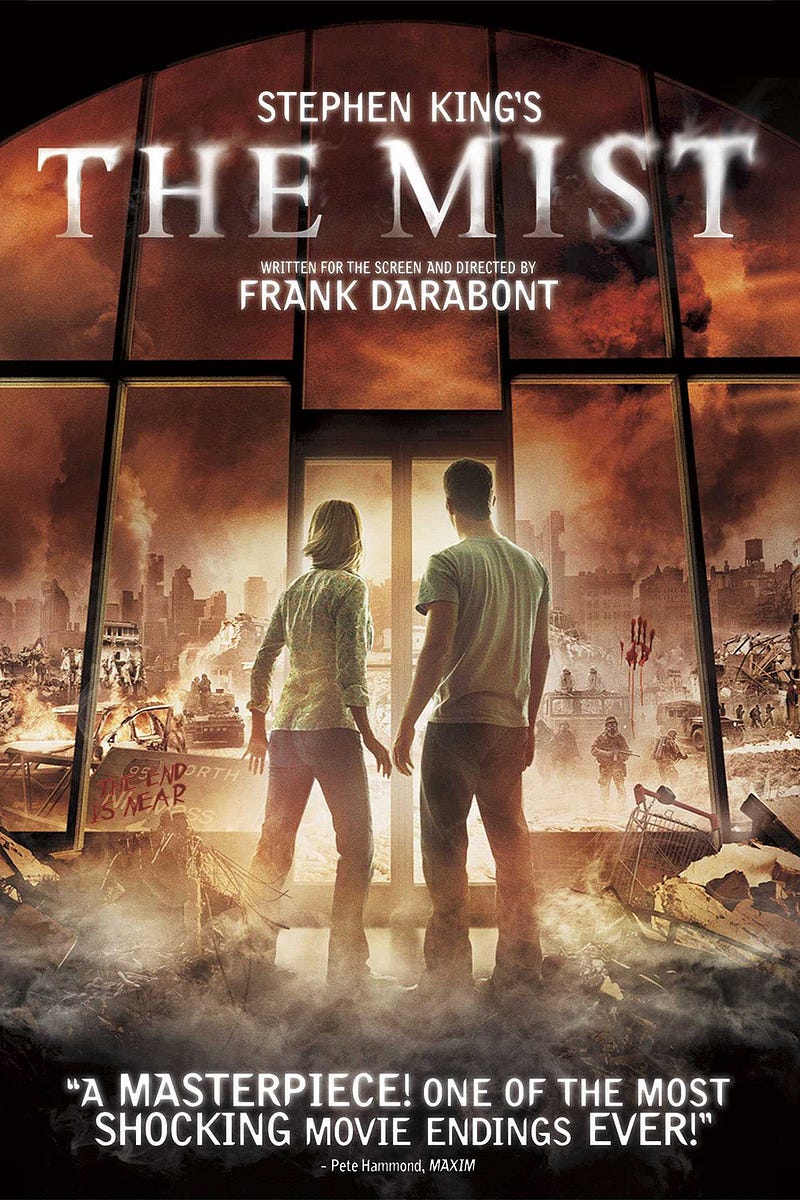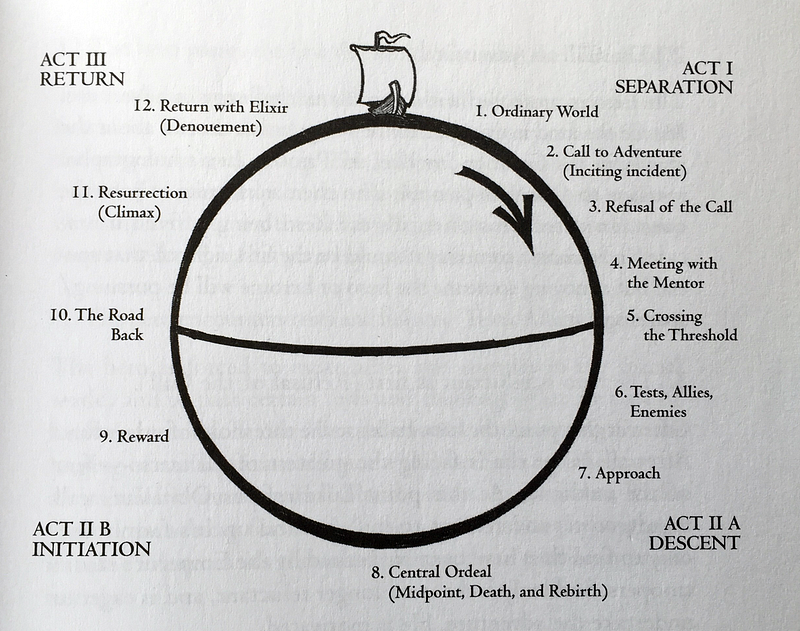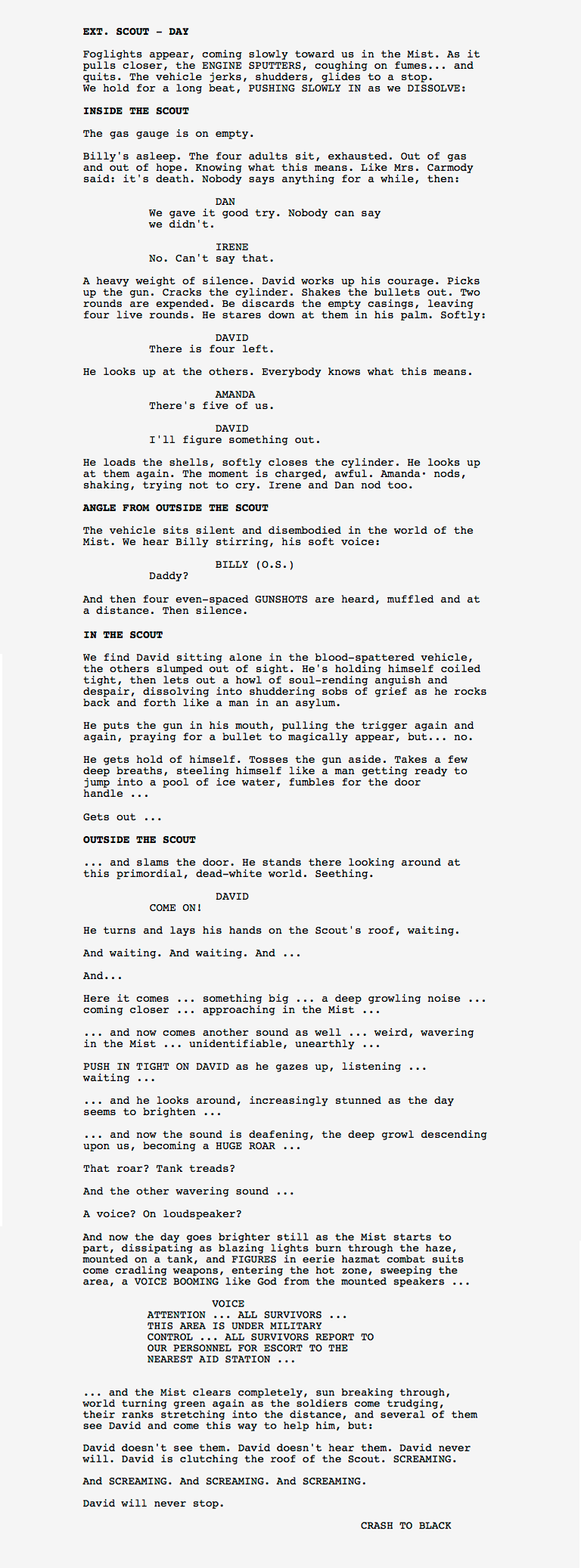Frank Darabont changed the ending of Stephen King’s novella. King loved it. Then, why did it rub so many people the wrong way? It might even have killed Frank Darabont’s directing career.
It has been almost 10 years since the movie was released in cinemas, and the new TV series based on the same Stephen King novella is about to premiere, so it’s time to take a second look at the movie and try to make sense of it all.
The the movie can be summarized like this: After a violent storm hits a small town in Maine, the protagonist, David, his small son, Billy, and their neighbor drive into town to get supplies. While they are in town, a strange omnipresent mist descends on the small community supermarket, and everyone inside gets stranded. The movie then follows all the other townspeople caught in the supermarket and how everything starts to unravel as they lose the ability to get out or to communicate with the outside world.
Misleading marketing
When The Mist came out in 2007, it was tailgating the mainstream horror revival of the early to mid-00s. It looked on paper like a guaranteed hit. It was based on a novella by Stephen King and written for the screen and directed by Frank Darabont. Darabont had previously made movies of two other Stephen King stories, namely The Green Mile and The Shawshank Redemption (well, 3 movies if you include the short film The Woman in the Room). The Shawshank Redemption has since been hailed as the best movie ever made, according to the users of IMDb.com.
Everything seemed to point to another success.
But the ending is so bleak it sparked a clear polarization of the audience; either you liked the ending, or you hated it, and the vast majority of the general audience seemed to hate it. So, what happened? Two things stand out, the marketing around the movie and the structure of the movie.

I’m no marketing expert, but the overemphasis on this movie being made by “the team who made the best movie of all time” seems foolhardy. This movie is different from The Green Mile and The Shawshank Redemption, and therein lies one problem with the movie. The marketing created a clear expectation in the audience of a similar movie experience, maybe with a bit more horror elements thrown in for good measure.
Frank Darabont’s roots in the horror genre were entirely skipped in the marketing. The two other movies are not accurate pointers of his work, neither before nor after. They are the odd ones out. He was, and still is, a writer/director with long and storied roots in the horror genre.
It’s easy to understand why so many members of the audience left the theater confused and bewildered and angry about the ending. This was not what they were expecting going into the cinema.
Playing against audience’s expectancy
If The Mist should be viewed as a mainstream suspenseful movie about what happens when society as we know it breaks down, then the movie must follow a known and established structure or else it veers away from being mainstream. And this does not seem to be Frank Darabont’s intentions.
King’s short story had David and Amanda having sex in the supermarket office during their time trapped there, a plot development that Darabont did not bring over to his film. The writer/director felt that such an act between two characters — each married to someone else — would not be well-accepted by a movie-going audience and would lead to them hating both characters. ‘I’m so not getting away with that on screen,’ he joked. ‘Not even trying.’
– Source: Grant Watson’s “As a species we’re fundamentally insane.”
This is a very interesting statement by Darabont. He was aware of what the audience would accept in terms of character development but still decided on the bleak ending, even insisting on it, as the movie studio forced him to cut the movie’s budget in half if he didn’t change the ending. He opted to keep the ending and made the movie for half the original budget.
Rhythm
Mainstream stories must follow certain rules. Similar to music having rhythm. If not the listener — no matter if they are musically trained or tone-deaf — will call out the music as out of tune or playing in disharmony.
One of the best known and, perhaps, most adopted ways of constructing stories in mainstream movies is The Hero’s Journey. Almost all (western) movies follow the three-act structure, with a clearly defined start, middle and end, wherein the middle (the second act) takes up about half the entire movie, and the first and third act bookending the middle takes up a fourth each.

1)Things start out in the normal world (before the mist descends on the town), and something happens, prompting the protagonist to go on a quest in the special world.
2) Here, the hero will find friends and foes, meet tasks and challenges. The 2nd act, the middle part of the movie, takes place in the special world, where nothing is as it seems, and the protagonist is constantly tested to determine his or her perseverance. It’s only when the hero has proven his or her worth they are shown the path back to the normal world.
3) The hero returns as the savior bringing back the sword to slay the dragon or the magic drink to heal the dying king.
Three well-defined acts and some markers along the way provide direction for the audience. It’s been the staple of almost all mainstream stories for centuries.
“Crash to black”
And this is where The Mist deviates from The Hero’s Journey. The protagonist David fails the final challenge. He does return to his normal world — by getting out of the supermarket — but in the process, he loses everything, his wife, his son, and everyone he cared for. He left the special world with nothing, and he doesn’t change as a person. He hasn’t learned anything or gained knowledge he didn’t have before. That’s about as bleak as it can be.
Below is the last two pages of the screenplay. And whereas the novella by Stephen King ended with an ambivalent ending with the survivors sitting in the car contemplating their options, Frank Darabont continued the story for a few minutes.

“CRASH TO BLACK” indeed.
By adding a few more minutes to the ending and making it as bleak as this, Frank Darabont punched the audience in the gut. Hard.
“In a story, what the reader feels is driven by what the protagonist feels. Story is visceral. We climb inside the protagonist’s skin and become sensate, feeling what he feels. Otherwise we have no port of entry, no point of view through which to see, evaluate, and experience the world the author has plunked us into.”
– Lisa Cron: Wired for Story
The protagonist is our entry into the universe of the movie. For good and bad, it’s how we view the world of the story. You have — as a storyteller — a great responsibility towards the audience.
Watch the entirety of the last 8 minutes of The Mist below.
Tricked
Christopher Vogler writes in his seminal work on The Hero’s Journey and screenwriting “The Writer’s Journey”:
“The Hero’s Journey is a skeletal framework that should be fleshed out with the details and surprises of the individual story. The structure should not call attention to itself, nor should it be followed precisely. The order of the stages given here is one of many possible variations. The stages can be deleted, added to, and drastically shuffled without losing any of their power.” (Vogler, p. 19)
The problem — story structure wise — with The Mist is it calls attention to itself. If you, as a storyteller, rip out the audience’s hearts during the movie, you have to give it back to them at the end. If you don’t follow the structure, to some extent, you give the audience a bad taste in their mouth.
The movie could also have ended with the massive monster they meet on the highway simply crushing the car underfoot, killing everyone inside. SPLAT! End of story. And that would have left the audience just as bewildered because the story skips of elements of The Hero’s Journey.
When you, as a filmmaker play on the expectations of the audience, you have to deliver in a certain way. Failing to do so will leave the audience disliking the story. The audience feels tricked.
In The Mist, there is no resolution to the story. This is why, at the premiere, so many people reported watching the audience leave the theater in complete silence. They were in shock; they just watching a father shoot his own son only to be rescued minutes later. But they were also silent because they were trying to figure out why the movie felt so wrong. There was something missing from the story, or something felt off kilter.
I perfectly understand — and respect — why many liked the ending, precisely for its hard bleakness. It was very different. But, if you are trying to create a universally understandable narrative for the general audience, you have to play along with some expectations from the audience. Expectations which are rooted in a long storytelling tradition.
If not, you run the chance of undoing the entire narrative and making your story a one-trick pony. Once you’ve seen the movie, there is little point in seeing it again, because the trick it plays on the audience only works the first time around.
Thanks for reading!
If you enjoyed this, please consider sharing this article with others.